Alwoodley Golf Club, Leeds
Leeds, England

The Wigton Moor Whin provides an attractive backdrop to several holes. Much of Alwoodley’s interior is an open heathland subject to bracing breezes off the Yorkshire Moors.
Dr. Alister MacKenzie claimed that Alwoodley and Moortown were as important to the north of England as Sunningdale and Woking were to the south – and he was right.
When construction at Alwoodley started in the winter of 1907, inland golf course architecture in England was ordinary and fell well short of producing the hazards/challenges that made links golf at such courses as Deal and St. George’s so inspiring.
As detailed by Tom MacWood in Arts & Crafts, inland bunker and green designs were geometric and rudimentary. Hazards looked forced upon the landscape and even worse, their placement lacked strategic merit. Squared-off, flat putting surfaces completed the dreary picture of inland golf.
The few noted exceptions included the think-tank at Woking and Willie Park’s work at Sunningdale Old and Huntercombe. Herbert Fowler’s Old Course at Walton Heath was the first course specifically designed with the Haskell ball in mind and it too marked a great step forward in inland architecture when the Great Triumvirate(Braid, Taylor and Vardon)opened it in 1904.
Starting with Stuart Paton’s placement of the central hazard in the 4th fairway at Woking in 1901 and culminating in the 1930s with West Sussex, an astonishing number of superb holes and inland courses were created throughout England. However, few could have guessed what was to come in 1907.
Typical examples of uninspired architecture could be found at Headingley Golf Club and Leeds Golf Club, both of which Alister MacKenzie was a member. According to Tom Doak in his book The Life and Work of Dr. Alister MacKenzie, the young doctor was not reticent about voicing his concerns about each design to the respective green committees.
Though little heed was paid to the thirty-five year old, MacKenzie nonetheless took to the study of golf course architecture as a hobby. When the opportunity presented itself with a group of local businessmen to build a new course, MacKenzie and his good friend and fellow architecture enthusiast Arthur Sykes pounced quickly.
The group of founding members for Alwoodley must surely have been impressed by the strength of MacKenzie’s convictions and design thoughts. Nonetheless, they called in Harry Shapland Colt to offer his valued opinion. Though Colt’s best work was yet to come for several years at such designs as Swinley Forest and St. George’s Hill, he (along with Willie Park and Herbert Fowler) was considered the preeminent architect of the time, in large part because of his active role as Secretary at the prestigious Sunningdale Golf Club. Nick Leefe, current Chairman of the Greens at Alwoodley, notes that ‘I too have to obtain the best available professional advice (agronomy/ecology) if I wish to make any alterations, which might affect the way the course is played. Nothing has changed.’
Colt walked the property and even stayed at MacKenzie’s house. Colt largely agreed with the routing and general layout that MacKenzie had already devised. Indeed, MacKenzie’s hand drawn routing of the course complete with notes is still proudly in the club’s possession today.
By great fortune, the winter of 1907 was a ‘wet and unpleasant’ one. Colt had returned to London and of the committee in charge of building the course, only Arthur Sykes, MacKenzie and the green keeper ventured out onto the course in the poor weather. Thus, according to MacKenzie, ‘we were able to disregard their views entirely and make the course exactly as we wished.’
When the course opened for play in the summer of 1907, it represented a stunning advancement in inland golf course architecture, as we see below.
Holes to Note
Third hole, 515 yards; Like the 6th hole at Piping Rock on Long Island in the United States, the day’s hole location makes a marked difference in how tricky the hole plays.Played across the heath, the right half of the green is an extension of the putting surface. When the hole is located here, the play of the hole is fairly straightforward and the tiger golfer is keen to card a ‘4’. However, the hole becomes much more vexing when the hole location is moved left into a natural depression. The golfer must now position his second shot down the far right of the fairway to gain the advantageous angle into the left half of the green; otherwise, his approach must carry directly over the heather and fescues. As the hole generally plays downwind, clearing the rough stuff and stopping the ball quickly can be problematic.
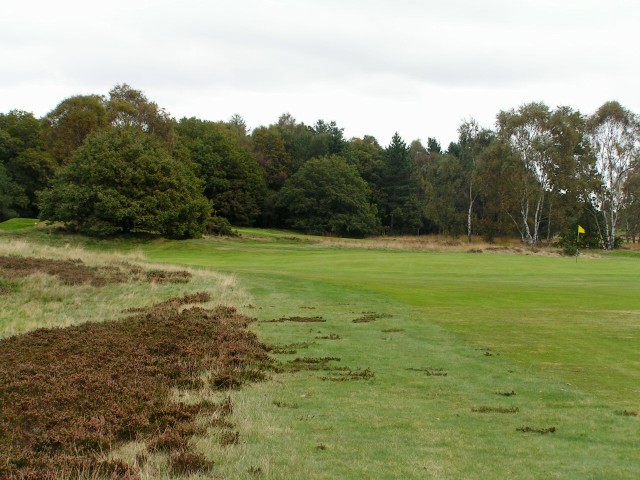
The right half of the third green is an extension of the fairway. The left half, much of which is obscured in the photograph above, is down in a hollow.
Fourth hole, 480 yards; Alwoodley has the reputation as being amongst the best conditioned courses in the United Kingdom. However, unlike in the United States where that distinction is often horribly misused and refers to courses that are extremely green and artificial in appearance, in this case, best conditioned means providing the golfer with fast and true playing surfaces. The greens are always superb and the fairways provide a uniform playing surface. As the playing conditions relate to this hole, the 4th is the only hole on the front that plays in a westerly direction. As such, it is often into the wind, providing the golfer with a glimpse of how tough his task shall be as he heads in from the 13th. On one such day, the author witnessed a low rolling hook shot from 200 plus yard out and the sight of the ball running fast and true down the fairway for the last 50 yards before coming to rest on the green was a testimony to the outstanding playing attributes that the sandy soil at Alwoodley provides for its members year around. The ground game at Alwoodley provides all class players with numerous playing options, hole after hole, and this variety helps elevate Alwoodley relative to many of MacKenzie’s later works in the United States.

As seen down the fourth, Alwoodley occupies an acidic heathland and is justly famed for its tight springy fairways. The fairway even looks ‘fast’ in the photograph above.

The beautiful fourth green complex is pictured above. To its left is the shared tee complex for the fifth and seventeenth tees. The sixteenth green is behind the heather and gorse on the far side of the fourth green. All in all, MacKenzie showed great routing flair within this 75 yard area of the property.
Fifth hole, 370 yards; No architect has ever built more appealing holes in the 350 to 400 yard range than Alister MacKenzie. The list of truly world class holes is unmatched. Ranging from the 9th at Lahinch to the 5th at Crystal Downs to the 13th at Cypress Point to the 3rd on the West Course at Royal Melbourne, the list goes on and on. The 5th at Alwoodley is just such a hole.

One of inland golf’s glorious views can be found from the elevated fifth tee. Note how the sharp left to right slope of the fairway often dictates an approach…

…over this string of bunkers that protrude from the right front of the green.
Sixth hole, 420 yards; The Old Course at St. Andrews was far and away MacKenzie’s favourite golf course (or at least his favourite that he didn’t design!). One of its attributes is the mix of views that the golfer is given from the tee: sometimes all is in sight; sometimes only a portion of the fairway can be glimpsed and other times, even less than that. However, the golfer is always given the option of trying to accomplish something in order to make his next shot easier. That same philosophy is captured here at the 6th. The easier to hit – but less advantageous – right portion of the fairway is in view from the tee. The level left side of the fairway makes for the shorter way home and provides a level stance. However, gorse obscures much of it from the tee and trouble in the form of heather and gorse continues down the left of the fairway. The golfer is free to decide: should h e take the risk off the tee and go left for the sake of a better approach or play the safer tee ball right and face the tougher approach?

The sixth fairway bleeds away to the right but the most level stance for one’s approach shot is found along the left portion of the fairway, much of which is partly to mostly obscured by gorse.
Seventh hole, 145 yards; Wind is a key factor at Alwoodley and as such, finding a hole of this length becomes especially a delight. Golf at the highest level is about controlling the flight of the ball in varied winds and when presented with a hole of this length, a golfer is often made keenly aware that he lacks the ability to control the ball low over such a short distance. MacKenzie’s 11th at Lahinch is another such hole.

Though modest in length, the seventh is deceptive. At 36 paces, the green is the deepest on the course and yet the bunkers actually come out to ‘greet’ the golfer: the right center bunker pictured above is 25 yards from the front edge of the green and the left and right bunker behind it are prior to the putting surface as well. The overall effect is one of visual trickery and only the man that trusts in the yardages will fly a ball past the front middle of the green. A brisk wind adds to the challenge.
Eighth hole, 535 yards; MacKenzie was a huge fan of dogleg holes as they required ‘judgment and headwork.’ Placing a bunker in the direct line forces all players to play to one side or the other and MacKenzie was one of the first to truly embrace this design philosophy.

The three shot 8th swings to the left 140 yards from the green, which is exactly where Colt and MacKenzie agreed to place this oblong shaped bunker.
Ninth – 11th holes, 190, 475, 165yards, respectively; In terms of routing a course, MacKenzie later wrote in The Spirit of St. Andrews that’ It is true that there are certain general considerations which should influence us in routing a course. It is an advantage to start off with three or four long holes to get people away. It is also advisable to arrange the short holes so that they will be a rest after playing one or more of the long ones.’ Sounds like a perfect description of Alwoodley.
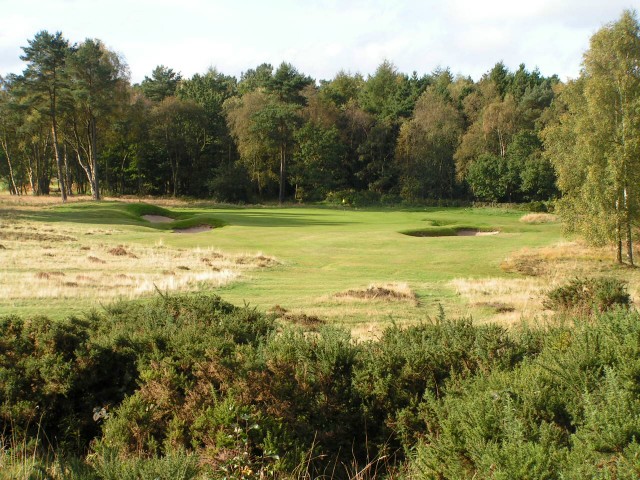
As was MacKenzie’s preference, the long three shot eighth is followed by the one shot ninth. The difficult tenth is followed by another very good one shotter.
Thirteenth hole, 395 yards; The author has played few courses with as fine a collection of two shot holes as Alwoodley. Their variety makes them special; no two are remotely alike. In the case of the 13th, the biggest green on the course at over 10,000 square feet is the standout architectural feature. Unlike the geometric greens being built by others at the time, this one is more free form as it widens in the middle before narrowing in the back. Also, MacKenzie believed that hazards were being built too far away from the greens and the four bunkers that circle the 13th putting surface are flush against it, creating numerous interesting hole locations and recovery shots.

As seen from near the tee, the thirteenth is one of the most attractive two shotters on the course. Many small trees and scrub bushes were cleared from the general area around and behind the green. Much to the Green Committee’s credit, they left the magnificent oak at the back right of the green.
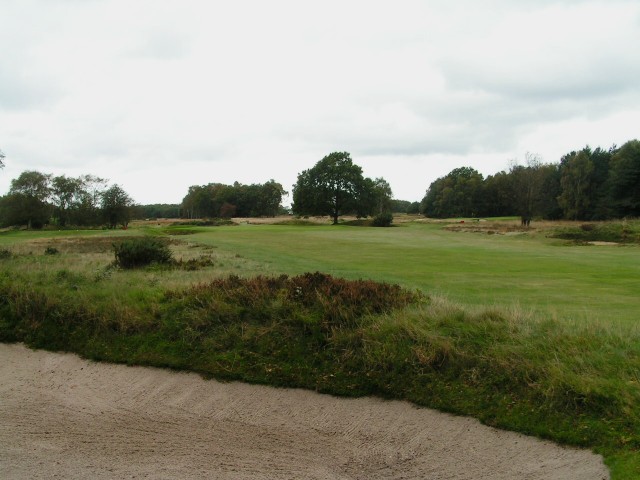
Though Ganton (some forty-five minutes east of Leeds) is famous for its bunkers, the ones at Alwoodley are hazards too.

As seen from sixty yards short, the thirteenth green widens behind the front left bunker, creating interesting hole locations.
Fourteenth hole, 205 yards; MacKenzie wrote in 1933 that Alwoodley ‘still has a more natural appearance than perhaps any other inland course.’ In part, what he was referring to was how well the man-made features blended in with the natural features of the property. In the case of the 14th, the green complex is completely manufactured(i.e. built-up)but it looks like it is a part of nature. Other than Park, Colt, and Fowler, no other architect was displaying such a talent in 1907 when course construction started.(Speaking of Fowler, Alwoodley’s present Chairman of the Green Nick Leefe notes that ‘it is not widely known that our Committee in the very early days called in Fowler specifically to look at and report on the bunkers.’ Leefe believes this was done in 1908).

Though wonderfully simple in appearance from the tee, the fourteenth is full of danger: a six foot deep bunker hugs the left of the built-up green, the right greenside bunker is only slightly less shallow and the front half of the green is steeply pitched from back to front.
Fifteenth hole, 410 yards; MacKenzie, a Scot, appreciated the design lessons on offer at The Old Course at St. Andrews as well as anyone before or since. Part of the lessons of The Old Course center around the use of out of bounds but unlike there, MacKenzie had the unusual opportunity on the back nine at Alwoodley to have the out of the bounds on both sides of the fairway. At the dogleg left 10th, the out of bounds is down the player’s left while at the dogleg right 15th, it is on his right. No one shot pattern is favoured and the player who can work the ball both ways has the advantage (as he should).
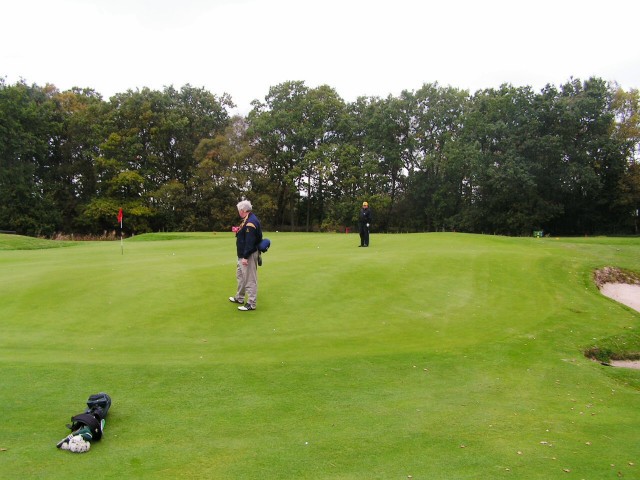
Though a wild green by any standard, the fifteenth must have been a startling creation in 1907. The diagonal ridge that Mark Rowlinson is standing on feeds many a ball toward the right greenside bunker.
Sixteenth hole, 415 yards; MacKenzieis the undisputed master at building courses for all class players, another lesson that he learned from the Old Course at St. Andrews. One of his secrets was to keep forced carries to a minimum. Along with the tee ball at the 2nd where he takes the golfer to higher ground, the only other forced aerial carry shot on the course is here at the 16th.

The view from the sixteenth tee is more daunting than it plays as the carry is less than 60 yards to reach the fairway.

The imaginative and irregular shaped bunkers at Alwoodley were a harbinger of MacKenzie’s artistic talent and represent a huge improvement on what was being built elsewhere in England at the turn of the century.
Seventeenth hole, 435 yards; The club property line is left, so not surprisingly, the best angle into the 17th green is from left center. MacKenzie would later question the lasting merit of a blind approach shot as he felt it might lose some strategic appeal with time. Would MacKenzie have designed this hole in the same manner late in his career as he did at the start? One can only hope so! Judging the approach to take the slope and feed onto the green is one of the most fun approach shots on the course.
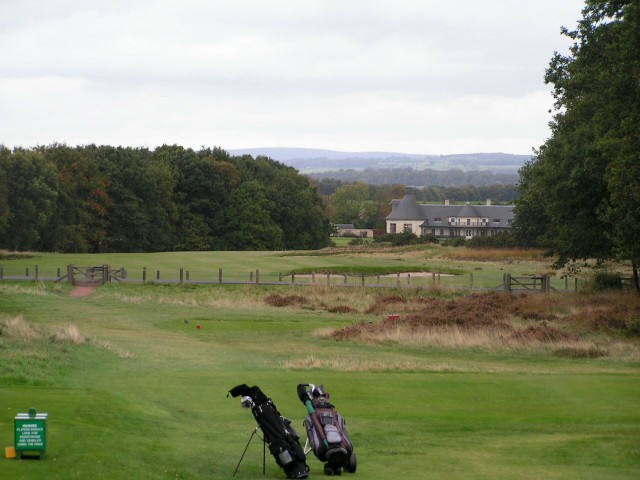
The green cannot be seen from the elevated seventeenth tee as it is below the brow of the distant hill, roughly in line with the edge of the trees. Alwoodley’s handsome clubhouse is the far distance.

As seen from behind the seventeenth green, the sweep of the land and the extended flagstick indicate the blind nature of the green.
Consistent with other MacKenzie courses with which the author is familiar, Alwoodley lacks an indifferent or poor hole. In fact, the 10th and 11th holes which are not photographed above are often cited as being among the best in Britain. Some even credit the dogleg 10th as it sweeps left around the out of bounds as being the inspiration for the 13th at Augusta National.
In addition to its collection of holes, Alwoodley’s other great attribute is that it remains every bit as invigorating a walk today as it was in MacKenzie’s day. In recent years, the Green Committee cleared much of the scrub and brush that often grows on a heath if left unchecked. The picture of Alwoodley today is of an open, expansive course. The vistas and uncluttered nature of the course heighten one’s sense of being alive, of being well.
As uncovered by Richard Mandell in an upcoming book on Pinehurst, Richard Tufts wrote in 1898 about the game of golf that,
Everybody can play it – some excellently, others indifferently, still others very badly but all enjoyably. It keeps the player out in the open air; it keeps him moving over wide spaces; it exercises all his muscles and all his wits. It is an ideal sport for the maintenance of bodily and mental health.
Doctor MacKenzie often preached of the benefits of playing golf and of being outside. For instance,he wrote in The Spirit of St. Andrews that,
The chief thing to bear in mind is that golf is a recreation and a means for giving us health and pleasure… One of the reasons why I, a medical man, decided to give up medicine and take to golf architecture was my firm conviction of the extraordinary influence on health of pleasurable excitement, especially when combined with fresh air and exercise.
This is at the heart of why golf is such a great game and few places better underscore this point than historic Alwoodley.
The End



![Minchinhampton (Old) [2016]](https://golfclubatlas.com/wp-content/uploads/2018/09/Minchinhampton-500x383.jpg)
![St. Enodoc (Church) [2017]](https://golfclubatlas.com/wp-content/uploads/2017/11/St.-Enodoc-500x383.jpg)

![Sunningdale (Old) [2014]](https://golfclubatlas.com/wp-content/uploads/2017/11/Sunningdale-Old-Course-500x383.jpg)

